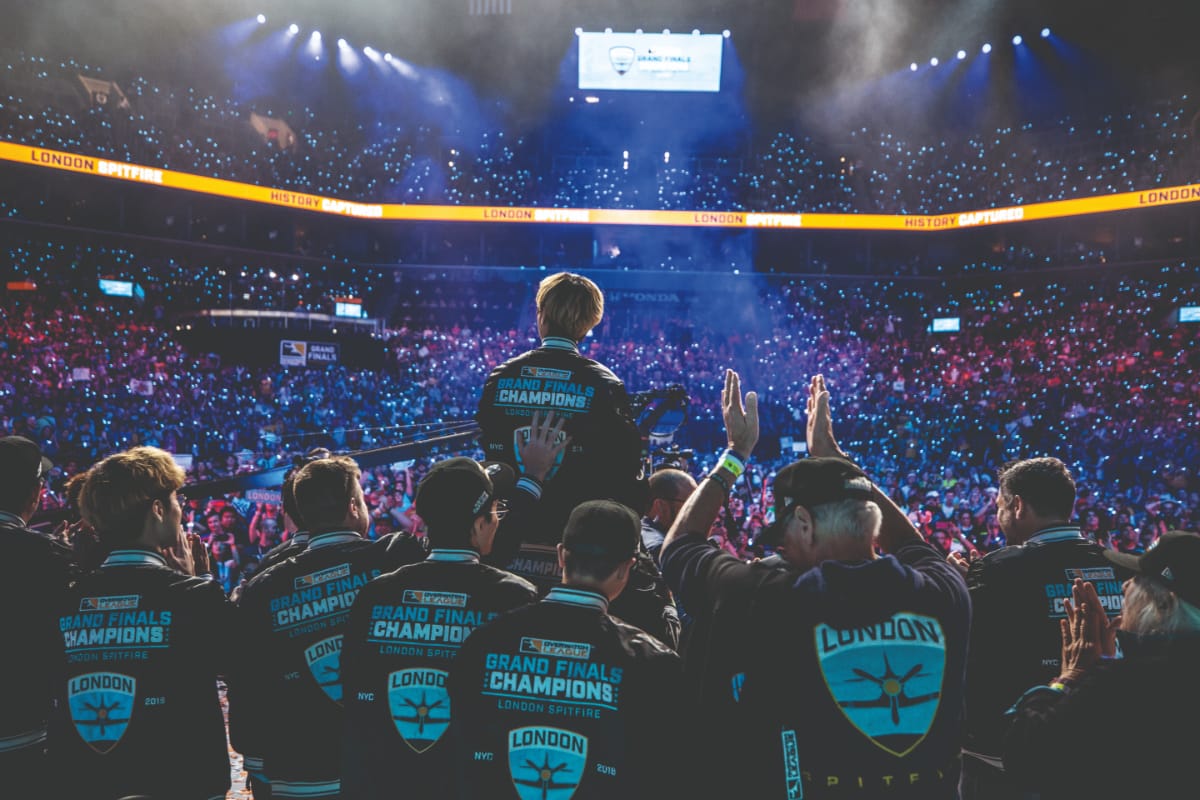DJ Khaled had something to say. The burly hip-hop star emerged from behind a plume of smoke on a sleek stage inside the Barclays Center in Brooklyn as thousands of people howled with excitement. “Man, this is incredible!” he yelled into a microphone. Just like in his current gig with Jay-Z and Beyoncé, Khaled was the opening act. The main attraction: two teams of six competitors trained to pulverize each other in a showdown for more than $1 million in prize money and a bulky, trident-shaped trophy. This was the Overwatch Grand Finals, a Super Bowl of sorts for a league that the New York Times has called “the epicenter of the e-sports universe.” The action was about to play out not on a court or a field, but on huge screens, in the virtual world of a wildly popular video game.
If you’re puzzled by the notion of a packed arena filled with people cheering for athletes who mash buttons, not wide receivers, you might want to pull up a chair. E-sports leagues have sprouted around the world with increasing frequency and sophistication in the past decade; the Overwatch League is just the latest outgrowth of an industry that’s on track to crack $1 billion in revenue within the next year. The top players are in their teens and early 20s and have names you might not recognize. But the executives betting big on some of the most successful e-sports franchises in the country are plenty familiar, like Philadelphia 76ers co-owners Josh Harris W86 and David Blitzer W91 and New England Patriots owner Robert Kraft.
Tucker Roberts W13, the president of Comcast NBCUniversal’s e-sports team, was in Brooklyn for the Grand Finals to cheer for his squad, the Philadelphia Fusion. In keeping with the city’s tradition of sports underdogs, the Fusion managed to claw their way to the championships, where they were set to face the heavily favored London Spitfire. More than 10 million people tuned in on streaming platforms like Twitch and legacy networks like ESPN, with a higher share of 18-to-34-year-olds than the Super Bowl or the NBA Finals. Some viewers were die-hard fans. Others—DJ Khaled included—just wanted to catch a glimpse of a growing global phenomenon.

Philadelphia Fusion president Tucker Roberts W13 at the Overwatch finals. (Photograph by MacKenzie Stroh)
Level Up
Even from the video game industry’s early days, it was clear that video games had the potential to bring large numbers of people together. Stanford University hosted the first e-sports contest in 1972, with competitors playing SpaceWar for a subscription to Rolling Stone. In 1980, Atari held a national Space Invaders tournament in New York that attracted 10,000 applicants. Ten years later, Nintendo took the tournament concept on the road, hosting the Nintendo World Championships in 29 cities. (Competitors vied for very ’90s prizes: a $10,000 savings bond, a Geo Metro convertible, and a Super Mario trophy.)
As consoles—and then portable devices, PCs, and internet connections—became ubiquitous, so did the question of whether gaming’s growing popularity could add up to something bigger. The answer arrived in South Korea in 2000. Government officials decided to capitalize on a noticeable interest in gaming competitions by establishing an official e-sports association to support and promote the industry with the same seriousness reserved in the U.S. for football and baseball. South Korean TV stations began broadcasting e-sports content 24 hours a day.
Two years later, an organization called Major League Gaming was created in New York, planting a flag of sorts for e-sports in the U.S. By 2006, MLG had convinced a cable network to air a tournament of the first-person shooter game Halo 2. A generational shift started to emerge: Younger video-game fans were just as happy to be spectators, watching the best gamers narrate their way through hours of footage of themselves playing on YouTube and, later, Twitch, which is now owned by Amazon.
Other seismic developments followed. In 2009, the developer Riot Games released League of Legends, a multiplayer battle-arena computer game now played by 27 million people every day. A League of Legends championship was held at the Staples Center in Los Angeles in 2013, marking the first time that an e-sports event was held in such an attention-grabbing setting—the house the Los Angeles Lakers built.
“You started to hear rumblings about e-sports,” says Michelle Young, director of operations for the Wharton Sports Business Initiative. She recalled learning in 2015 that former Lakers stars Rick Fox and Shaquille O’Neal had both purchased their own e-sports organizations—a signal to the world of professional sports that video gaming might be worth their attention.
“And then in the next nine to 12 months,” Young adds, “it just exploded.”
The Big Buy

E-Sports Pioneers: NBA and NHL owners Josh Harris W86 and David Blitzer W91 are all in on pro video gaming. (Photo: Andy Marlin/Stringer)
For e-sports to achieve mainstream legitimacy in the U.S., the industry was going to need more than just a few famous ex-athletes investing some retirement money. Enter David Blitzer, who nearly did a double take when he read an article in 2015 about Madison Square Garden selling out for an event he’d never heard of—the League of Legends championship. “That was the first light bulb for me,” he says. “I said, ‘I need to go see this and figure out what’s going on here.’”
Blitzer spent hours at the Garden, quizzing Riot Games officials about the industry as the competition unfolded. (“It was louder than a Knicks or Rangers game,” he recalls.) He shared his findings with Harris, his partner in Harris Blitzer Sports & Entertainment, a holding company that owns the Sixers, the New Jersey Devils, and Crystal Palace FC, an English soccer club. They started to wonder if e-sports should be their next investment.
In what proved to be a little slice of serendipity, Harris and Blitzer were soon in London on business and decided to have drinks with Michael O’Dell, the founder of Team Dignitas, an e-sports company that competes in a wide range of games, including League of Legends and Counter-Strike: Global Offensive, and has produced a string of top teams in Europe. O’Dell offered an insider’s account of the industry’s challenges—the revenue side was still a puzzle—and the upside: Experts peg the number of e-sports enthusiasts around the world at 165 million, while the overall number of gamers stands at a staggering 2.3 billion.
In September of 2016, HBSE purchased Team Dignitas and another team, Apex Gaming, and merged them, thus becoming the first professional sports owners in the country to enter the e-sports arena. “That was a major moment,” says Akshay Khanna G15 WG15, who was then the Sixers’ vice president of strategy. “I don’t think it was a no-brainer, because investing money is never a no-brainer. But we all saw the potential for growth.”
Harris and Blitzer brought in Michael Prindiville, a former NBCUniversal executive, to oversee Team Dignitas operations, and shared some of the sports science research that was being conducted at the Sixers’ state-of-the-art practice facility. They also invested in PowerSpike, an e-sports marketing and analytics company, and incubated an algorithm-driven e-sports training platform. Team Dignitas fields eight teams that compete in seven different e-sports games; earlier this year, it won the championship for Rocket League, which combines soccer and … race cars. “I’ve enjoyed watching the teams more than I would’ve thought,” Harris laughs. “I’m getting hooked.”
After catching the e-sports bug, the duo found more pathways into the marketplace. When the NBA announced it would launch an e-sports league for its NBA2K franchise in 2017, the Sixers were among the first teams to join; the 76ers Gaming Club won the league’s first tournament in May, earning a $35,000 prize. Through the Sixers Innovation Lab, a startup incubator, they’re also supporting U GIT GUD, an e-sports company that analyzes public data from League of Legends to help players improve their performance.
It wasn’t long before other pro sports owners reached out to Harris and Blitzer, trying to figure out if they, too, should dive into the e-sports pool. “In the beginning,” Blitzer says, “the answer was, ‘This space is real, it’s exploding, and we want to have some seats at the table, but we can’t tell you what the business model will be.’”
The marketing firm Newzoo recently reported that e-sports industry revenue would hit $906 million this year, with sponsorships accounting for the largest piece of the pie, at $359 million. Advertising was expected to net $173 million, while media rights for tournaments would generate another $160 million. Ticket sales and merchandising, meanwhile, added up to just $95 million. Newzoo predicted the industry is still five to 10 years away from fully maturing. The financial incentives for professional gamers are expected to grow along with the industry. For now, the pay scale varies wildly, with some League of Legends players reportedly earning a minimum of $12,500 for a 28-match season while competitors in the less-than-a-year-old Overwatch League are paid $50,000 to $150,000. Successful e-sports teams can nab millions in prize money as well.
“At the end of the day, the industry has a lot of interest and fan engagement, and it’s generating a ton of content. But how it all plays out is unclear,” Harris says. “To a large extent, participation at this point is a bit of a lottery ticket in terms of the economic value creation.”
The idea of a billion-dollar lottery ticket sounded plenty good to some of Harris and Blitzer’s peers.
A Digital Tidal Wave
Search the e-sports landscape and you’ll find plenty of other Wharton alums who are helping to chart this sea change in competition and entertainment consumption. Brandon Bagley W11 is the vice president of operations at Infinite Esports & Entertainment, a holding company that was founded by Neil Leibman, a co-owner of the Texas Rangers. Infinite has a stable of e-sports teams that includes OpTic Gaming, which competes in League of Legends and Call of Duty, and the Houston Outlaws, which was among the first wave of franchises in the Overwatch League.
The company plans to open a $10 million e-sports-only arena in Arlington later this year. Bagley believes the industry will grow more mainstream during the next decade but points out that its reach is already massive. “Will kids one day know e-sports players as well as they know LeBron James? I don’t know,” he says. “But go to a middle school now. How many of the kids know Ninja, and how many know Cole Hamels?” (We’ll pause here for a brief translation. “Ninja” is the online alias of Tyler Blevins, a 27-year-old professional gamer from Illinois. He has three million Twitter followers. Hamels, a World Series MVP, has fewer than 50,000.)
It’s unclear what the popularity of e-sports among younger generations will mean for traditional pro sports. A 2017 study from Street & Smith’s Sports Business Journal found that the average age of a Major League Baseball TV viewer was 57, while the average ages for NFL, NHL, and NBA viewers were 50, 49, and 42, respectively. Meanwhile, nearly 63 percent of those playing Fortnite—the inescapable mobile game that’s made $1 billion since being released last autumn—fall within the coveted 18-to-24-year-old demographic. Can three-plus-hour baseball games hold the attention of a teenager accustomed to the sensory overload of Rocket League?
Broadcasters are hedging their bets. In July, Disney reached a multi-year deal with gaming developer Blizzard Entertainment to broadcast the Overwatch Grand Finals on ABC, ESPN, and a handful of other channels—a move that was perhaps aimed at both attracting younger viewers and introducing e-sports to older audiences. “That [post-millennial] generation is not watching TV or waking up and putting SportsCenter on,” Michelle Young says.
Passion for the industry runs deeper in Asia, where gaming culture is more ingrained and American sports have less of a footing. South Korea recognized e-sports as a second-level Olympic sport in 2015, and this past August, e-sports made its debut at a major global athletic event with an exhibition during the Asian Games in Indonesia. China is also a gaming hotbed, with estimates of more than 300 million gamers nationwide by 2020; a 2017 industry report noted that e-sports revenues in China alone accounted for $164 million. With so much potential for growth, it’s no surprise that two of China’s biggest internet and tech titans are slugging it out over e-sports domination: Tencent is investing $150 million per year in the space, while Alibaba has supported non-violent games for inclusion in the Olympics—a plan which, if approved, would keep Tencent’s popular fighting-based titles from the world’s biggest sporting stage.
Abraham Wyner, a professor of statistics at the Wharton School, spoke at an e-sports conference in Shanghai in June. He cautions against worrying too much about the NFL or NBA getting usurped by the gaming industry. “It’s hard to make forecasts,” he says. “There’s plenty of room for e-sports to grow, but I can’t see it replacing conventional sports.” But while Harris and Blitzer were the first owners to grasp the potential of e-sports, it’s safe to say others have caught up. The NBA, NHL, and NFL have all launched e-sports leagues built around licensed video games, ensuring that they connect with younger fans who are interested in their sports and their athletes. Garrett Breeden W16 is the NFL’s manager of gaming and e-sports, a position that affords him a close look at the league’s Madden NFL Club Championship. “We like the aspirational nature of these tournaments,” Breeden writes in an email. “A fan can go from their couch to representing their favorite team to being crowned a champion.”
Christian Dieckmann G06 WG06 thinks e-sports could be well positioned to offer fans experiences that traditional sports can’t rival. Dieckmann, chief strategy officer at the live entertainment tech company 3D Live, argues that e-sports tournaments are typically held in spaces that aren’t built to showcase video games. Growing demand could lead to the construction of more e-sports-specific venues that offer immersive, mixed-reality presentations of the games. “Most people out there who don’t have kids or don’t play video games won’t see this tidal wave coming,” he says. “But it is coming.” (Add the e-sports community to the growing list of those affected by violence and reexamining security measures: In late August, a 24-year-old gamer named David Katz opened fire at a Madden tournament in Jacksonville. Katz, who reportedly had a history of mental illness, killed two competitors, Taylor Robertson and Elijah Clayton, and wounded 10 others before turning a gun on himself.)
Count Dan Schwab W91 and his brother, Michael Schwab W85, among the few who did realize that a paradigm shift was under way. The Schwabs are co-presidents of the Pennsylvania-based D&H Distributing Company, a $4 billion technology distributor that counts Microsoft, Dell, Sony, and HP among its vendor partners. “Three to four years ago, we saw an inflection point start to occur,” Dan Schwab explains. Technology manufacturers began investing more money in features that hard-core gamers craved: monitors with faster refresh rates, machines with staggering processing power. More and more people wanted devices that were tailored (or could be) for extensive tournaments. “It was almost like the space race,” he says. “They’ll get the early indicators, and they’ll invest ahead of the curve.”
Schwab’s company helped put Harrisburg University of Science and Technology on the e-sports map last year, co-sponsoring the creation of an e-sports program at the school and an elaborate theater at the nearby Whitaker Center for Science and the Arts. The university now offers 15 scholarships for e-sports players and will host a two-day e-sports festival and tournament this fall. “You could close your eyes and look out five years from now and see this as being like March Madness,” Schwab says wistfully. “This is going to be a major phenomenon.”
The End of the Beginning?

Ahead of the Game: Members of the London Spitfire celebrate their championship win. (Photo: Robert Paul for Blizzard Entertainment)
Comcast doled out a reported $20 million last fall for a franchise in the Overwatch League, which debuted this year and focuses entirely on the eponymous dizzying, team-based shooter-
adventure game. But the newly christened Philadelphia Fusion was the last team to join the league and had to frantically play catch-up with everybody else.
“The first 60 or 90 days, we didn’t take one day off,” Tucker Roberts says. A manager and marketing team needed to be hired. Visas had to be arranged for the Fusion’s 12 players, who came from all over the world: South Korea, Israel, Finland, Spain, Russia. Comcast housed the new teammates in a 7,000-square-foot mansion in Burbank with a personal chef. The team missed the preseason; the regular season ran from January to June.
This wasn’t Roberts’s first foray into e-sports; he interned for Activision Blizzard in 2011, when he was still studying at Wharton, and handled logistics for gamers appearing at a Call of Duty convention in Los Angeles at which Kanye West performed. “I had never been to an e-sports event,” Roberts says, “and just thought, ‘Wow. This is kind of cool.’”
In giving its 12 franchises geographic roots—from Dallas and San Francisco to Shanghai and Seoul—the Overwatch League bore a slight resemblance to traditional pro sports. But all of the teams played their matches in a Burbank arena. Roberts hopes that will change over the next few years as teams put down roots in their home cities. “We’ll make our move to Philadelphia. We’ll have an e-sports venue, but not just some converted space,” he says. “I can’t wait to have home games.” The team has already started cultivating a footprint in the city, hosting watch parties as the Fusion made an unlikely run through the playoffs. Teams in other cities like Boston and Los Angeles worked from a similar playbook, inviting fans to have a beer together and watch their squads on big-screen TVs. (In September, the newest Overwatch franchise was purchased for Washington, D.C., by entrepreneur, investor, and tennis team owner Mark Ein W86.)
That the Fusion made it to the finals in its first year seemed a continuation of the divine luck that shined on Philadelphia’s normally miserable professional sports teams for most of 2018. More than 22,000 fans filled the Barclays Center for two days in July, and plenty were rooting for the Fusion. Play-by-play announcers narrated the matches as they unfolded on massive monitors above the crowd; the Fusion and London Spitfire players battled to escort a payload through a medieval-looking town or defended their positions from attack in a futuristic realm.
By the time the last on-screen avatar suffered its fate, London beat the Fusion soundly, but that seemed fitting. (Rocky lost his first fight with Apollo Creed, after all.) As the spectators streamed towards the exits, two men stopped to reflect on what they’d watched. John Weiss, a 26-year-old in an Allen Iverson jersey, and his pal, Chuck Patterson, were dazzled, plain and simple. “It was amazing,” Patterson said, with a wide grin. Weiss, meanwhile, is an intense gamer who knows what it’s like to get strange looks when discussing his passion. To him, the packed arena and the loud, euphoric crowd meant something more, something deeper—they served as proof that a cultural transformation was under way. “I feel vindicated,” he said.
David Gambacorta is an investigative reporter at the Philadelphia Inquirer and a freelance writer.
Published as “Welcome to the Billion-Dollar Business of E-Sports” in the Fall/Winter 2018 issue of Wharton Magazine.


























